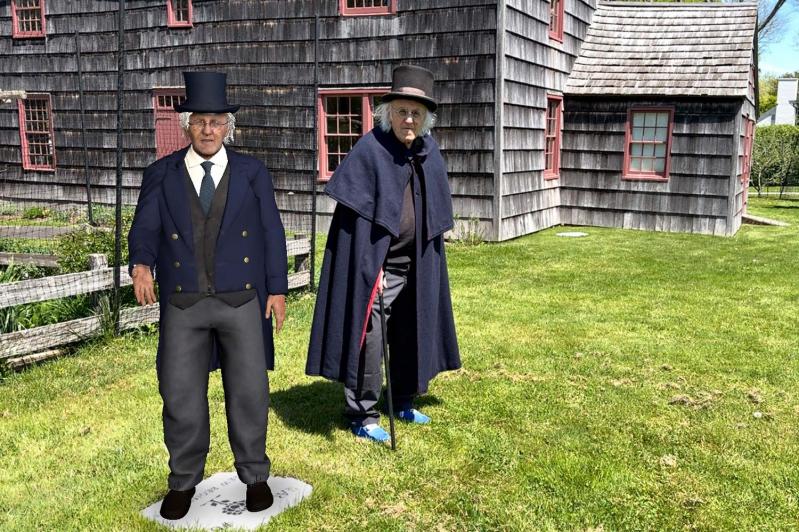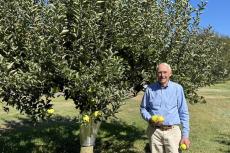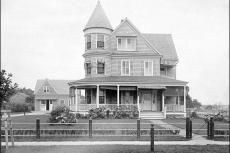It’s fair to say that Hugh King, the East Hampton Town historian, is more at ease sharing interesting tidbits from, say, the 1829 town trustees minutes than he is with augmented reality or the notion of a digital avatar. But despite himself, he came face to face with both earlier this week at the historic Mulford Farm.
There, the East Hampton Historical Society is putting Mr. King’s likeness to work to tell the story of the role the farm’s owner, Col. David Mulford, played in the leadup to the 1776 Battle of Long Island, and of his fate during the region’s subsequent occupation by the British. It is a story that Mr. King knows well and has shared often with visitors and those who join in the walking tours he leads for the society, dressed in his signature top hat and dark blue wool cloak.
Now, however, his image and voice are being used in an augmented-reality tour of the farm developed for the 1776AR app, thanks to funding from the Robert David Lion Gardiner Foundation. Download the app, point your smartphone at one of six engraved stones placed around the farmhouse, and up pops Mr. King’s avatar to share a chapter of the farm’s history as it relates to the American Revolution.
Colonel Mulford, who lived on the farm in 1776 with his wife, Phebe, and their children, was a leader of the preparations for the Revolution, with 768 officers and privates under his command. When the Patriots were defeated at the Battle of Long Island and the region fell under British occupation, of the 242 households in East Hampton, 151 heads of household fled to Connecticut, Mr. King tells visitors in the 1776AR tour. The colonel died in Connecticut of smallpox.
Walking the Mulford Farm grounds in tandem with the app tour, Steve Long, the historical society’s executive director, talked about the different avenues of American history that could be explored through Colonel Mulford’s story. One: “How does the farm continue on during the British occupation” without its head of household? “That’s really an opportunity to feature the story of the enslaved Africans that were here,” Mr. Long suggested.
The Gardiner Foundation has funded similar augmented-reality tours for sites across Long Island, he said, as part of “this whole digital-tapestry initiative” that focuses on African-American history, the American Revolution, and the story of Teddy Roosevelt. The Southampton African American Museum has one, as does the Montauk Historical Society. Other sites related to the Revolution with the A.R. tours include the Shelter Island and Oysterponds Historical Societies and the Greenwood Cemetery in Brooklyn.
When Mr. Long mentioned to Kathryn Curran, the executive director of the foundation, that the society was planning to reinterpret Mulford Farm, she urged him to apply for inclusion in the 1776AR project. The foundation then connected the historical society with a production company, 360 XR, that helped to hone the story that would be told in six segments of roughly three minutes each.
“Ideally, every historical organization that has an American Revolution-connected story would be doing this,” Mr. Long said. “I think about the Freedom Trail in Boston; wouldn’t it be great if there were a Long Island Heritage Trail here, especially on eastern Long Island.”
The A.R. tours won’t replace the real thing, but they will offer visitors a way to learn about the site even when it’s not open for in-person tours, and they might also pique the interest of a generation that is more accustomed to experiencing the world through handheld devices.
The society will officially launch the app tour on May 26 at 11:30 a.m., when Mr. King — the real one — will be on hand to expand upon the stories he narrates in the app.
Meanwhile, behind the scenes, the historical society is planning a climate-controlled collection storage center at Mulford Farm, and has recently won a $442,000 grant from the New York State Council on the Arts to support the effort. Mr. Long gestured toward the back of the farm property and a cluster of barn buildings. “That back building that you see is currently the collection storage, and it’s chock-full.”
With the new building, which was designed by Bruce Siska, the society wants to stick as closely as possible to the design of the other buildings at Mulford Farm, so that it won’t even register as being new. “We have the money in place to do the facility,” Mr. Long said, but more is needed for the storage and collection furnishings. “We’re designing all of that right now.”
When complete, the facility will be able to properly accommodate a collection of some 20,000 artifacts that visitors will have a chance to see in exhibitions at other public-facing historical society spaces like Clinton Academy.




